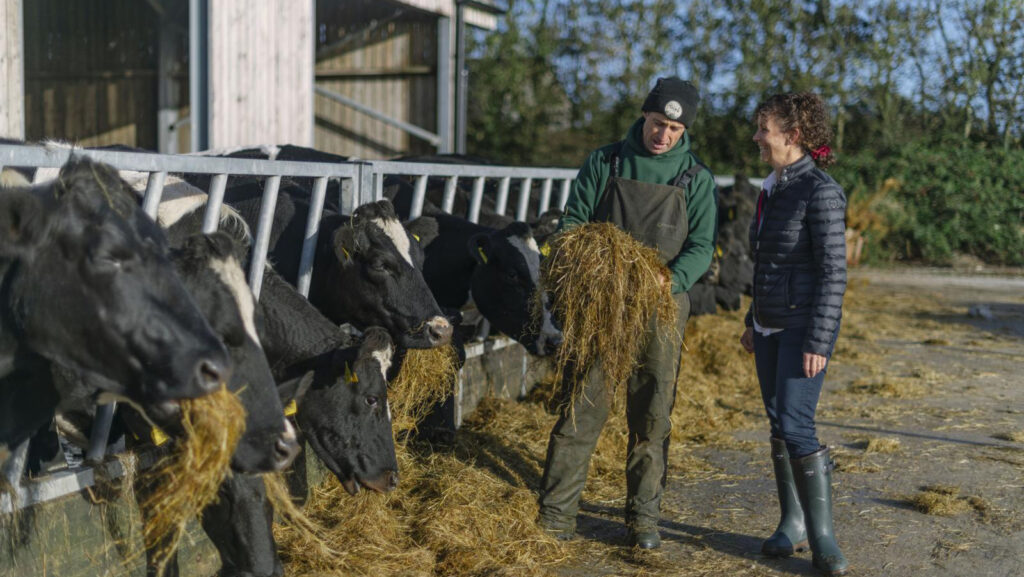Late-summer grass growth refills silage stocks and grows heifers
 Chris and Rachel Knowles © Jim Wileman
Chris and Rachel Knowles © Jim Wileman In this third of the series, Chris Knowles explains how he has improved heifer grazing and made it through a dry spell.
What has grass growth been like this summer?
We had a flush from mid to late May, then things really slowed up. We only got 37.5mm of rain in June, and paddocks that had got away and were cut then struggled to re-grow.
The trouble is, at that time of year, all it wants to do is go to head.
June and early July saw our poorest growth, then the weather suddenly turned. Grass stopped trying to head and for the past six weeks we’ve had a wonderful combination of heat and moisture.
We have been comfortably averaging 60kg of dry matter (DM)/ha a day every week.
See also: How lush spring growth is affecting summer grazing decisions
How does this compare with your five-year average?
We have had a summer of three sections: that normal surge of growth in May; then a struggle; and then, if moisture comes, it’s OK again – so fairly typical. It was cold here till mid-July, with cool northerly winds and temperatures not above 20C. We had one day over 25C.
What does this do to utilisation?
We have to keep on grazing grass in June, or it heads. We pre-mowed to get through and utilise the headed stuff.
Now, we can take about 12-16ha (30-40 acres) of surplus as bales, and we can be flexible as to whether it is used as a buffer or for winter feed for milking cows.
Your tips for successful pre-mowing?
We mow six to 12 hours before we graze, so in the afternoon for grazing the next morning. It needs to be done in good weather to get a wilt and not too high a cover: ideally around 3,500-4,000kg DM/ha.
Over 4,000kg DM/ha, it’s too heavy and you struggle to get a good wilt. Also, remember that you don’t want to be mowing poor-quality grass with dead material in the base, which is of poor hygiene and starts to smell as it decomposes.
If you push cows to eat rubbish – even pre-mown – you will lose milk.
Tell us how the heifer grazing has progressed this season
It’s gone well. We have measured fortnightly, and it has been averaging about 50kg DM/ha a day.
We haven’t fed any supplements and body condition is good.
Utilisation is better, and because we have grazed the platform more efficiently, we have grown more grass on it.
As a result, we have had more surplus to cut and bale. We also have the option to reseed 10% of the area next week.
What’s cow performance like?
They are being fed 3kg of cake a cow a day and are averaging 16 litres, which I’m pretty pleased with on our system. They are about 180 days in milk, and we are on a 10-in-7 routine.
And the October calvers?
Some of them dried off early and have been up on our moorland free-ranging on 32ha (80 acres) for the past six weeks.
They are fit for calving. The rest will have been dried off in August, then put onto deferred grazing – it’s not quite standing hay.
They will all come indoors to calve from 1 October. Managing this second group to graze round the edges of our platform – near moorland, where grazing can be rougher – has utilised poorer grass.
Have you been able to replenish silage stocks?
We budgeted for 2,500 bales and are close, we could be about 100 short. It’s about right for going into winter and better than last year. We should be able to withstand an abnormal spring in 2025.
Any other fieldwork happening?
We are liming where we are reseeding, applying 5t/ha. Our pH was 5.5 and, with high organic matter in the mid-teens and peat-type soils near moorland, we find it naturally dips to 4.5-5.
As we bed on sand, we usually end up spreading sand in our slurry, which helps keep the pH sensible.
There will also be about 31kg/ha of nitrogen going on behind the cows, between now and mid-September, to support the last round of the year.
Explain how you set up your final grazing round
I decide when it starts – usually about 5-6 October. Then I try to get average farm cover as high as I can and make sure I graze one-fiftieth of the platform; this takes us to the end of November.
As 20% of our herd is calving in October this year, this will reduce demand as these cows will be housed and on silage. The spring calvers will then have a larger area to graze.
We will keep feeding them 3kg of cake, as the grass could be wet at that time of year, and we want to maintain condition and milk yield. We might get 15 litres a cow off grazed grass; they won’t be on silage.
I’m now making sure that the sward is eaten out to prepare for the autumn flush of good-quality growth. It is harder near the end of the season as there are more dung pats and rejection areas.
It’s important to not be afraid of mowing to reset the residual at this time. It needn’t be all the field: sometimes it is just part of it, especially where cows lie in certain areas, or you have sloping fields or trees.
